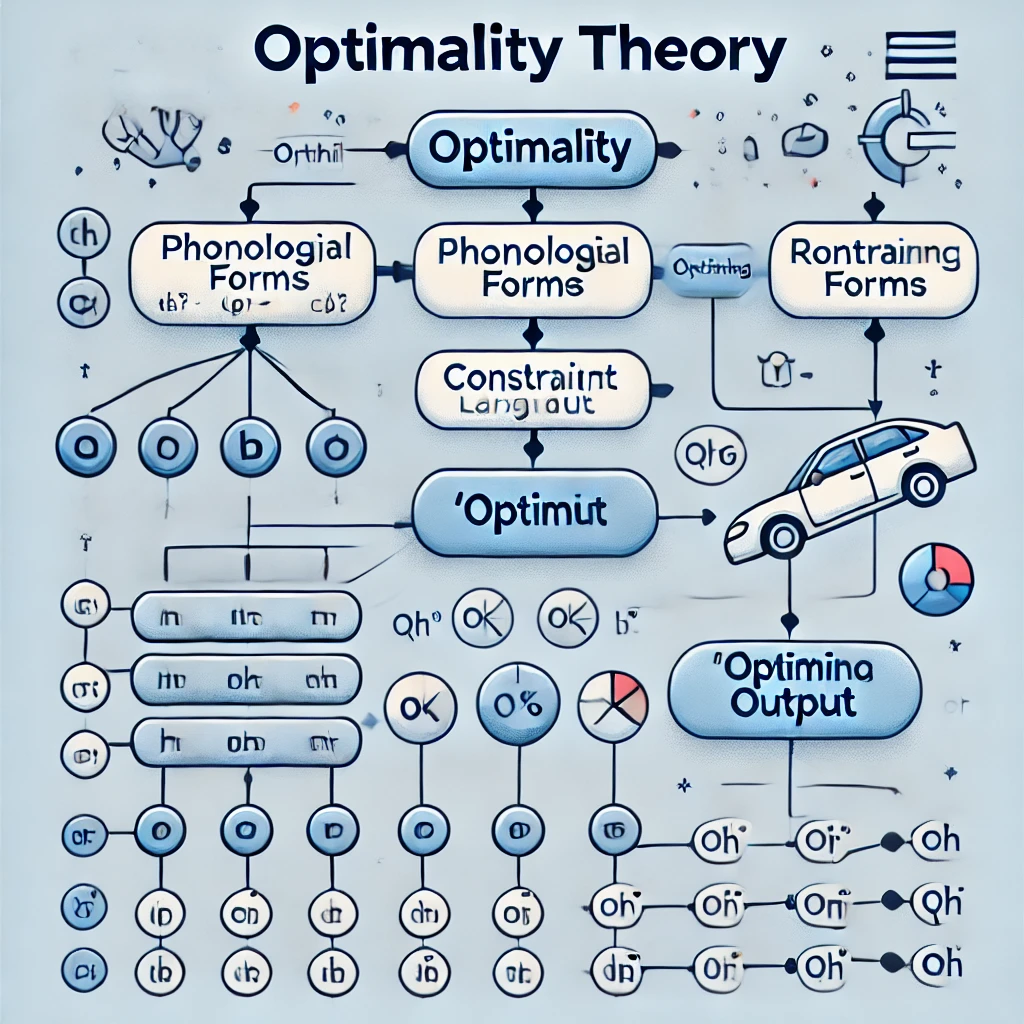What is Optimality Theory? A Guide to the Linguistic Framework
Optimality Theory (OT) is a theoretical framework in linguistics that explains how different language forms are derived from underlying structures. Developed in the early 1990s by linguists Alan Prince and Paul Smolensky, OT is widely applied in phonology, morphology, and syntax to understand the variability and constraints in language formation. Unlike traditional approaches, which often assume strict rules governing language patterns, OT proposes that language structures arise from competing constraints that are prioritized differently in various languages.
In this guide, we’ll delve into the principles, components, and applications of Optimality Theory, along with its strengths and limitations.
1. Origins and Development of Optimality Theory
Optimality Theory emerged as an alternative to Generative Phonology, a rule-based approach that dominated linguistic theory for several decades. Prince and Smolensky introduced OT in their 1993 work, Optimality Theory: Constraint Interaction in Generative Grammar. Their framework sought to explain language variations by emphasizing constraints rather than deterministic rules, providing a flexible model for understanding cross-linguistic diversity.
Since its inception, OT has grown in influence, particularly within phonology, the study of sound systems in language. It has since been applied to other areas, including syntax and morphology, to explore how languages generate complex structures through hierarchical constraints.
2. Core Principles of Optimality Theory
Optimality Theory is grounded in three key principles that describe how language outputs are derived from inputs (underlying structures) through constraints:
a. Constraints
The Constraints are central to OT and represent the “rules” that guide language formation. Constraints are divided into two main types:
- Markedness Constraints: These constraints demand that outputs adhere to certain preferred linguistic forms, often by avoiding complexity. For example, a markedness constraint might favor simple syllable structures like CV (consonant-vowel) over complex structures like CCV (consonant-consonant-vowel).
- Faithfulness Constraints: These constraints ensure that the output remains faithful to the input. They work to preserve elements of the underlying form in the surface output, such as maintaining specific sounds or syllable structures.
These constraints are universal across languages, but each language ranks and prioritizes them differently, leading to cross-linguistic variation.
b. Ranking of Constraints
In OT, constraints are not absolute rules but are ranked hierarchically. Languages vary based on how they prioritize certain constraints over others, resulting in different outputs from the same underlying form. This flexibility allows OT to account for the diversity of language forms across the world.
For example:
- Language A might rank a markedness constraint higher, leading to simpler syllable structures.
- Language B might prioritize faithfulness constraints, preserving more of the input form in the output.
c. Optimal Candidate Selection
When an input is processed, the OT model generates multiple possible outputs or candidates that satisfy constraints to varying degrees. An evaluation process then ranks these candidates against the ordered constraints. The candidate that best satisfies the constraints, while violating the least significant ones, is chosen as the optimal output.
This concept of choosing an optimal output aligns OT with natural selection, where the “fittest” output emerges based on constraint satisfaction.
3. Components of Optimality Theory
Optimality Theory consists of several components that work together to derive outputs from inputs:
a. Generator (GEN)
The generator, or GEN, creates a set of possible outputs (candidates) for a given input. These candidates include all potential forms that the input could take, adhering to the language’s phonological, morphological, or syntactic properties.
b. Constraints (CON)
The constraints, as mentioned, are universal rules that assess candidate forms. In OT, the set of constraints (CON) applies universally across languages but varies in rank from one language to another.
c. Evaluator (EVAL)
The evaluator, or EVAL, compares candidates generated by GEN against the ranked constraints. EVAL determines the optimal output by selecting the candidate that best satisfies the higher-ranked constraints and minimally violates lower-ranked ones.
For example, if an input form “/cat/” could yield candidates like “cat,” “ca,” or “catta,” the evaluator will choose the form that best satisfies the constraints specific to that language.
4. Applications of Optimality Theory
Optimality Theory is primarily applied in the following linguistic domains:
a. Phonology
Phonology is where OT has had the most significant impact. OT explains why languages favor certain sound patterns and syllable structures by ranking markedness and faithfulness constraints. For instance, OT can account for why English prefers consonant-vowel (CV) syllables over consonant clusters, which are more marked.
b. Morphology
In morphology, OT helps explain word formation by considering constraints on word structure and complexity. For instance, it may clarify why some languages simplify or omit morphemes in specific contexts to satisfy markedness constraints, while others retain them to remain faithful to the underlying form.
c. Syntax
Although OT is less commonly used in syntax, it offers insights into sentence structure and word order preferences across languages. In syntax, constraints can influence word arrangement, agreement rules, and sentence complexity.
5. Strengths of Optimality Theory
Optimality Theory has several notable advantages, making it a popular framework in contemporary linguistics:
a. Flexibility and Universality
OT’s universal constraints apply to all languages, but the flexibility in ranking allows it to explain cross-linguistic differences effectively. This adaptability makes OT useful for analyzing linguistic diversity.
b. Explanation of Variability
Because OT derives outputs based on optimality rather than strict rules, it provides a robust explanation for variation within and across languages. It accounts for why certain phonological or morphological forms are preferred in one language but disfavored in another.
c. Compatibility with Cognitive Processes
OT aligns with cognitive models of language, where competing forces shape language output. This compatibility with cognitive theories has strengthened OT’s role in linguistic research, particularly in psycholinguistics.
6. Limitations and Criticisms of Optimality Theory
Despite its strengths, OT also has limitations and has faced criticism in linguistic circles:
a. Lack of Predictive Power
Critics argue that OT is sometimes limited in its predictive capacity because constraints can be adjusted to fit the data retrospectively. This flexibility, while advantageous, can make it difficult to predict language patterns without a comprehensive ranking of constraints.
b. Complexity in Ranking Constraints
As the number of constraints grows, determining the exact ranking for a particular language can become highly complex and subjective, requiring extensive linguistic data and analysis.
c. Difficulty with Exception Cases
OT struggles to account for exceptions in language, particularly in cases where languages have irregular forms that do not follow the ranked constraints. In such instances, OT requires additional modifications or assumptions to explain these anomalies.
d. Challenges in Syntax Application
While OT is well-suited to phonology, its application in syntax is less developed. The complexity of syntactic structures often makes it difficult to identify appropriate constraints and rank them meaningfully.
7. Future Directions and Evolution of Optimality Theory
Optimality Theory continues to evolve as linguists apply it to new areas and refine its principles. Researchers are exploring how OT can be integrated with other linguistic models, such as Harmonic Grammar and Stochastic OT, which introduce probabilistic or weighted constraints to account for variation and exceptions more effectively.
Advances in computational linguistics and machine learning are also opening new avenues for OT, enabling researchers to use data-driven methods to test and rank constraints across large linguistic datasets. These interdisciplinary approaches may help address OT’s limitations and expand its applicability.
Conclusion
Optimality Theory provides a compelling framework for understanding how language structures emerge from competing constraints rather than rigid rules. By prioritizing constraints differently, OT explains the diversity in phonology, morphology, and syntax across languages, making it a valuable tool in linguistic analysis. While the theory faces challenges, particularly in handling exceptions and complex syntactic structures, its adaptability and cognitive alignment continue to drive its use in modern linguistics.
As researchers further refine OT and integrate it with probabilistic models, it may evolve into an even more powerful tool for decoding the intricacies of human language, revealing new insights into how and why languages function the way they do.






